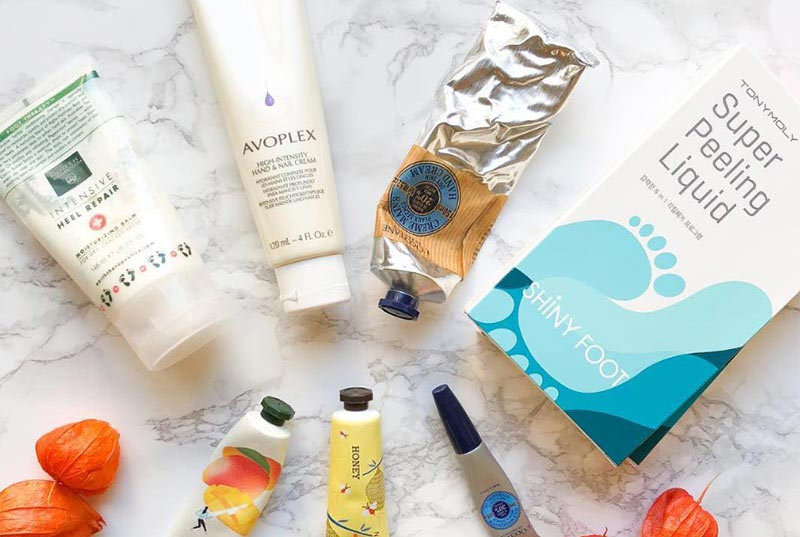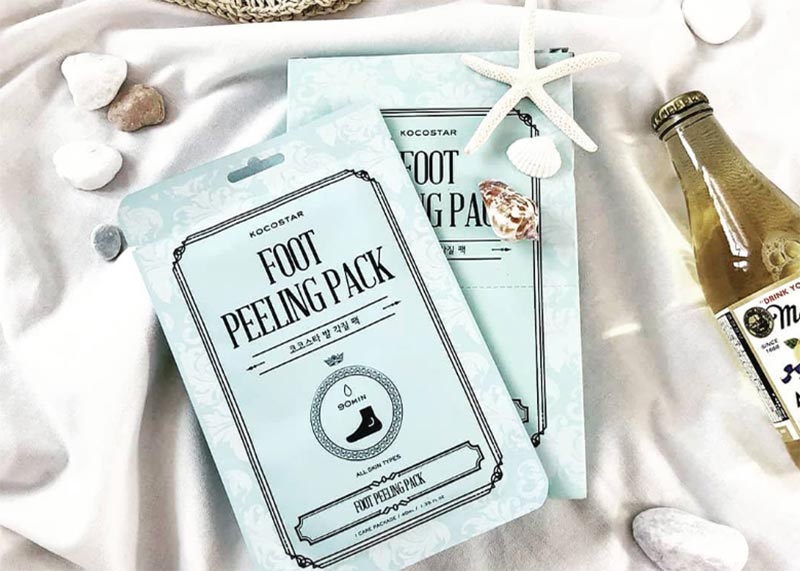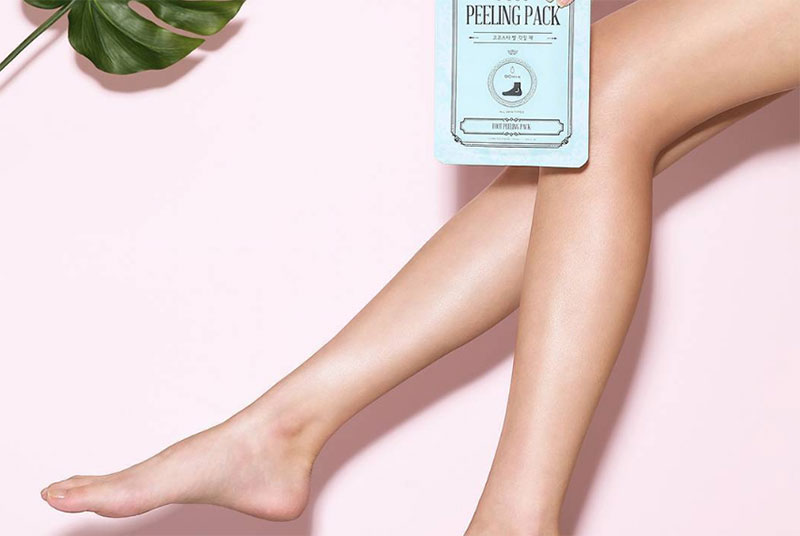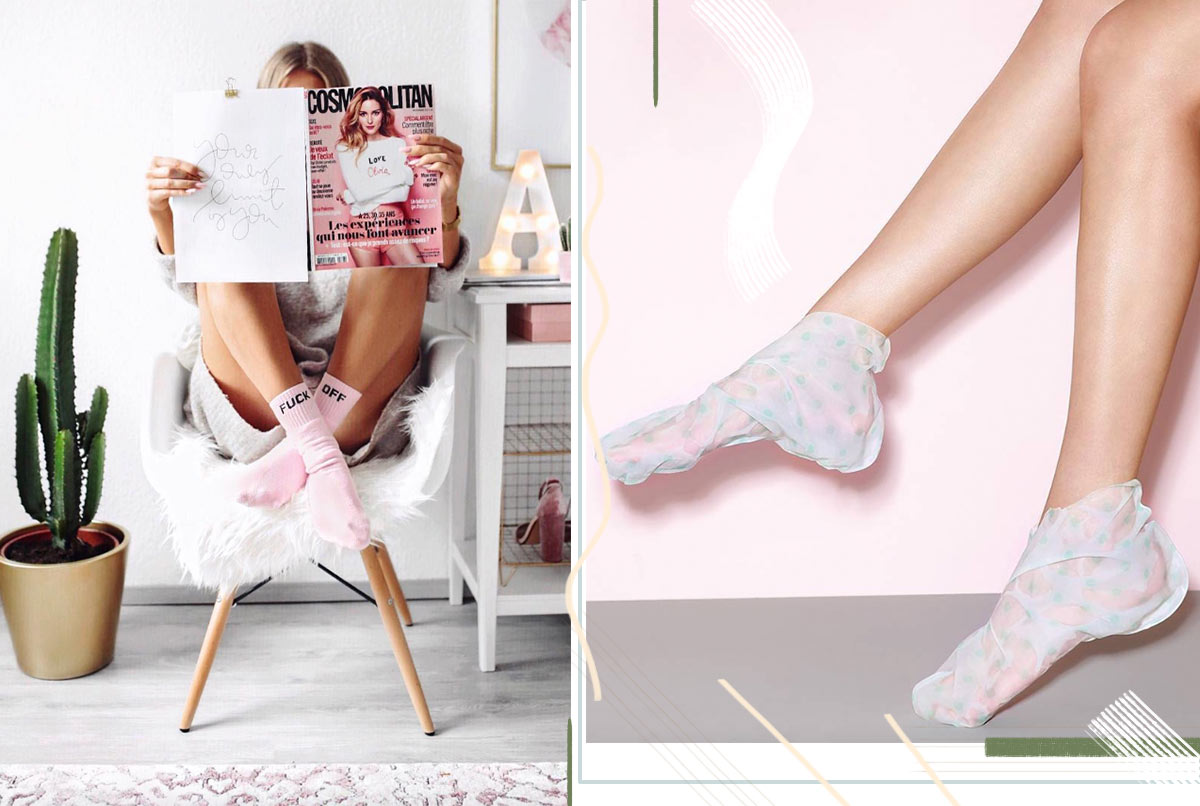- Foot peels are liquid-saturated plastic socks with chemical peels that help your feet shed layers of dead skin over time.
- AHAs, BHA, urea, enzymes, and nourishing ingredients are the key components of foot peeling masks.
- The peeling process can last around 7 days, and you can have great results for 2-3 months.
If you long for soft, smooth feet, you’ve come to the right place. Foot peeling masks are remarkable products designed to transform the feet, especially if they’re dry and callused. The peeling masks remove dead skin from the feet with a blend of acids and enzymes, saving you the need to labor with foot files or pumice stones. Using them is a simple, relaxing experience that offers dramatic results.
Whether you’ve already purchased a foot peel or you’re still considering, here are the things you need to know before using one. In this post, we explain what exfoliating socks are and how they work, their ingredients, the timeline for using them, and the step-by-step instructions for how to actually go through the process. Are you ready to transform your feet?
In this article:
- What Are Foot Peels and Exfoliating Socks All About?
- What Ingredients Do Foot Peels Contain?
- How Do Foot Peels Work?
- When Does the Dry Skin Peel off?
- Pros & Cons of Using Foot Peels & Masks
- Are Exfoliating Foot Masks Good for You?
- How to Use Foot Peeling Masks?
- Tips for Better Results During Peeling
- How Long Do the Results Last?
What Are Foot Peels and Exfoliating Socks All About?
Simply put, foot peeling masks are a little like sheet masks for your face but with an exfoliating component. The most popular one, Baby Foot, was designed in Japan in 1997. It took a little over a decade for folks in North America to notice and develop an obsession.
The Baby Foot Peel, specifically, is a prime example of what these products are normally like. In a box, you receive a pair of plastic bags (“booties”) that are filled with a peeling gel. You wear the plastic booties on your feet for a set amount of time, and either immediately after or after a few days, the feet begin to peel. By the end of the process, most of the dead skin is gone, and the feet are significantly smoother.

What Ingredients Do Foot Peels Contain?
Foot masks usually contain the same key ingredients you would expect in an acid peel or exfoliating serum. These ingredients are usually acids and other keratolytic agents that melt down the connective material that keeps dead skin cells attached to the skin and to one another. Once those ingredients penetrate into the top layers of the skin, they force dead skin to shed itself.
AHA
Alpha-hydroxy acids like glycolic acid and lactic acid are particularly popular, thanks to their tiny molecules that penetrate easily, as well as the hydrating effect that allows them to moisturize the feet.
BHA
Salicylic acid is also commonly included. While salicylic acid (sometimes also known as beta-hydroxy acid or BHA) has larger molecules than AHAs, it’s an oil-soluble ingredient, which means that it can cut through sebum and oils to offer a more thorough exfoliation.
Urea
Some foot peels also include high percentages of urea, which is a unique ingredient with both deeply moisturizing and exfoliating effects. Urea is particularly effective for treating calluses and corns on the feet.
Enzymes
Finally, some foot peels contain enzymes. These are ingredients like papain and bromelain that are derived from fruits like papaya and pineapple.
However, a foot peel that relies only on enzymes is not going to be as effective or powerful as one made with acids or urea. The exfoliating action of enzymes is much weaker, so they only offer a slight softening effect. When combined with other foot peel ingredients, however, they can do a great job.
Nourishing Ingredients
Not all foot masks are foot peels! Brands like Sephora, Baby Foot, and Earth Therapeutics also produce nourishing foot masks designed to soften and moisturize the feet without exfoliating them. These masks are usually made with the same ingredients you’ll find in a sheet mask or a foot cream, like various hydrating agents, plant butters, and oils. These masks can be used in combination with foot peeling masks for ultimate smoothness.
How Do Foot Peels Work?
The way foot peeling masks work is really remarkable. As we already explained, the exfoliating ingredients in the gel penetrate into the skin and cause the dead skin to shed all by itself.
Their dramatic effect occurs not just because of those ingredients, however. The “bootie” format of the mask is also responsible for the results. The plastic booties act as occlusives. They prevent any liquid from evaporating or rubbing off the feet, and instead, they force it to penetrate deeply through the layers of dry, dead skin.
Instead of causing the dead skin to come off immediately, the process is slow. The ingredients penetrate into the skin, and they work slowly and gradually. They induce a process of shedding that only starts a few days after you’ve used the peel and then lasts for up to a week. For some, the skin sheds in dramatic strips or sheets, while for others, it’s simple flakiness. Finally, all of the dead skin comes off, and the feet look renewed.

When Does the Dry Skin Peel off?
The timeline for the peeling differs from person to person and product to product. The majority of foot peels work on the following timeline:
- You leave the foot mask on your feet for about an hour.
- For 3 to 5 days, everything seems normal until the peeling starts suddenly. Once the dry skin starts peeling off, you can expect the peeling and shedding to last for 5 to 7 days before it can stop.
- This entire process goes super quickly for some users, while for others, it might take longer. On very rare occasions, it may not work at all, especially if you don’t have much dead skin build-up on your feet.
Because of this timeline, make sure not to try a foot peeling mask a few days before a special event or a vacation. If you do have specific plans to show off your feet, make sure to do the foot peel at least 2 to 3 weeks before the event.
Pros & Cons of Using Foot Peels & Masks
If you’re still not totally sure if using an exfoliating sock is for you, here’s a quick summary of the pros and cons of these products.
Pros
- Smoother, softer skin
- Eliminates calluses, corns, and dry patches
- The shedding process is very satisfying for some people
Cons
- You can overdo it if you’re not careful
- The peeling process is long and can be a little gross
- Not appropriate for certain skin conditions or foot issues
Are Exfoliating Foot Masks Good for You?
Exfoliating socks are amazing, but they are not entirely free of risk. In general, we’d say they’re mostly pretty good. The ingredients they contain are common, normal ingredients that you can see in many skincare products, so there’s nothing inherently harmful about them.
However, as with acid peels for the face, there are also some risks when it comes to using foot peels. Side effects are more likely to occur if you use the foot masks incorrectly or if you have a skin condition that makes your feet more sensitive or prone to damage.
In general, anyone with broken skin on their feet should avoid peeling masks until their feet heal. If you have a condition that causes rashes on your feet or you’re prone to fungus, you should avoid foot peels, as well.
Finally, some doctors caution against using foot peels if you have conditions that affect your ability to feel pain since you might not notice if the peel burns or tingles your feet.
If you do accidentally overuse the mask, you can expect to experience the normal side effects of over-exfoliation: mild stinging, redness, and dryness. This will go away on its own with time and gentle care.

How to Use Foot Peeling Masks?
So, you’re ready to go? Here are the simple steps to using exfoliating foot peels.
- Soak Your Feet
The best time to use a foot mask is right after a shower when your feet are clean and the skin is soft from the water. Most brands recommend you soak your feet for at least 15 minutes, as this makes the skin more permeable and the results more intense.
- Put on the Socks
Open the pack of exfoliating socks and gently slide each one over your foot. Make sure the gel inside the foot mask is thoroughly coating the bottoms of your feet.
- Leave on
Leave the exfoliating socks on your feet for around an hour, as directed by the packaging. You can put real socks over the booties if you’d like to walk around a little.
- Rinse
Once the hour passes, take off the foot peel mask, and wash your feet thoroughly with cool water and body wash or soap.
- Watch Them Peel
Once your feet start peeling, be careful not to tug or pull off any dead skin aggressively. You can help it along by pulling off skin that’s already pretty much separated, but if there’s any resistance, leave it be.
Tips for Better Results During Peeling
We wanted to include a few extra tips and hacks worth keeping in mind if you’re going to give exfoliating socks a try.
- The ingredients in the mask will absolutely wreck any nail polish on your toes, so make sure to remove it in advance.
- For the next two weeks or so, avoid moisturizing your feet, as this can prevent the peeling from occurring. If your feet are feeling very dry and you can’t stand not moisturizing, an oil-free lotion is the better choice.
- Continue soaking your feet in warm water on a daily basis every day after doing the foot peel. This will encourage better peeling.
- If you don’t think you’ve achieved great results the first time, you can leave the foot peel on for an extra 20 minutes the second time you do it to see what happens.

How Long Do the Results Last?
So, we’ve already explained the unusual timing of the foot peeling mask. You apply the mask for an hour, wait about a week, and then spend another week or so shedding like a snake. Once that’s all done, assuming the process works well and the shedding manages to occur, your feet will be silky smooth for at least a few more weeks.
Most users find that the results last easily for 2-3 months, although this also depends on how dry your skin is and how much pressure you put on your feet. However, if you decide that you want to try and shed some more after the first time, most exfoliating socks are safe to use 2 weeks apart.
Photos via @kocostar, @anajohnson, Instagram





